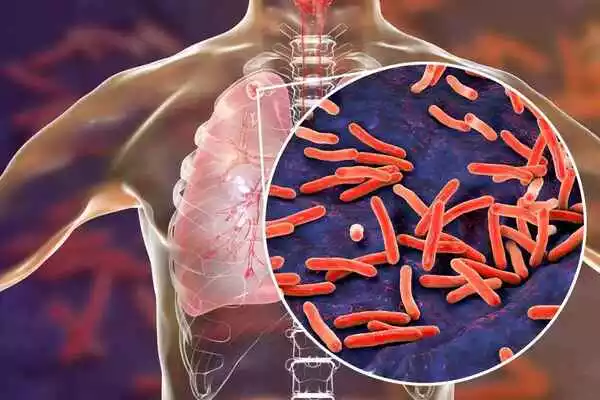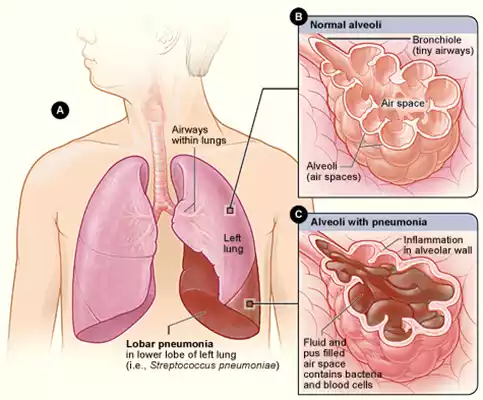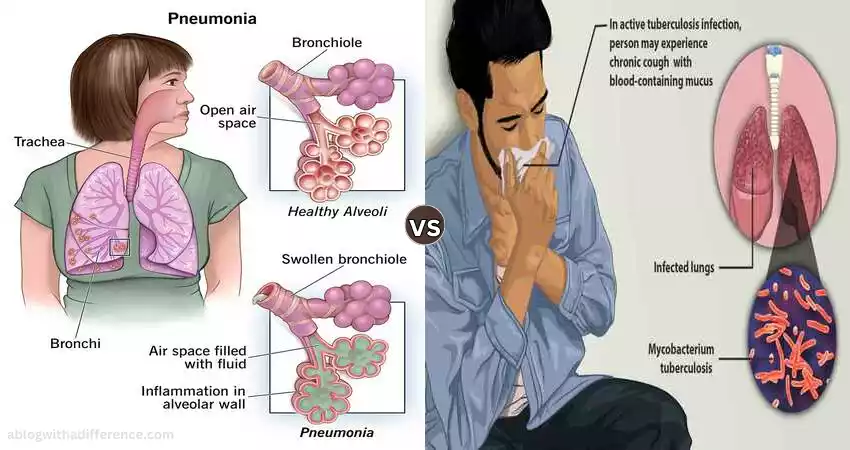Difference Between Tuberculosis and Pneumonia
Tuberculosis (TB) and pneumonia are distinct respiratory illnesses. TB is caused by Mycobacterium tuberculosis, transmitted through the air, primarily affecting the lungs but potentially impacting other organs. Its symptoms include persistent coughing, chest pain, and weight loss. Treatment involves a lengthy course of antibiotics.
In contrast, pneumonia, caused by various pathogens, leads to lung inflammation, causing symptoms like coughing, fever, and difficulty breathing. Antibiotics, specific to the infection type, treat bacterial pneumonia, while antivirals target viral strains. Differentiating between the two relies on diagnostic tests like X-rays and blood work. Both require prompt medical attention, but TB necessitates longer treatment. Understanding their differences aids in accurate diagnosis and appropriate treatment to ensure swift recovery.
What is Tuberculosis (TB)?
Tuberculosis (TB) is a transmissible bacteria-borne infection caused by Mycobacterium tuberculosis. It is most commonly affecting the lungs, but it can also be a problem for other parts of the body. The spread of TB is carried out when a person infected coughs, sneezes, or speaks, which releases tiny drops of the bacteria.
Once these bacteria enter the body, the immune system typically fights them off, leading to a latent TB infection where the bacteria remain inactive. However, in some cases, especially when the immune system is weakened, the bacteria can become active, causing symptoms and spreading the disease.
Symptoms of active TB can include persistent coughing (sometimes with blood), chest pain, fatigue, weight loss, fever, and night sweats. Diagnosis often involves a combination of medical history, physical exams, TB skin tests, blood tests, and imaging studies.
Treatment for TB usually involves a course of antibiotics taken for several months. It’s crucial to complete the full treatment regimen to eradicate the bacteria completely and reduce the risk of developing drug-resistant strains.
TB remains a significant global health concern, particularly in areas with limited access to healthcare and poor living conditions. However, with proper diagnosis, treatment, and public health measures like vaccination and infection control, TB can be effectively managed and prevented.

Complications of Tuberculosis
TB complications may include:
- Miliary TB: Occurs when the bacteria spread through the bloodstream, affecting multiple organs.
- TB Meningitis: Bacterial infection in the membranes surrounding the brain and spinal cord.
- Bone and Joint TB: Can damage bones and joints, causing pain and disabilities.
- Kidney TB: Affecting the kidneys, leading to kidney damage or failure.
- Spinal TB (Pott’s Disease): TB affects the spine, potentially causing back pain and spinal deformities.
What is Pneumonia?
Pneumonia is a very common respiratory illness that can affect the lungs. It occurs when the air sacs in the lungs, known as alveoli, become inflamed and filled with fluid or pus, making it difficult to breathe. This condition is usually caused by viruses, bacteria, fungi, or other microorganisms.
The most common symptoms of pneumonia include coughing (often producing mucus), chest pain, difficulty breathing, fever, chills, and fatigue. These symptoms can range from mild to severe, depending on the cause of the infection and the overall health of the affected person.
Pneumonia can affect people of all ages, but it tends to be more severe in infants, young children, the elderly, and individuals with weakened immune systems or underlying health conditions. Diagnosis often involves a physical exam, chest X-rays, blood tests, and sometimes, sputum tests to identify the specific cause of the infection.
Treatment for pneumonia depends on its cause. Bacterial pneumonia is typically treated with antibiotics, while antiviral medications are used for viral pneumonia. Rest, adequate hydration, and supportive care to alleviate symptoms are also essential for recovery.
Preventive measures such as vaccination (especially for influenza and pneumococcal pneumonia), good hygiene practices, avoiding smoking, and staying away from infected individuals can help reduce the risk of contracting pneumonia. Early detection and appropriate treatment are crucial for a speedy recovery from pneumonia.

Complications of Pneumonia
Pneumonia complications may involve:
- Respiratory Failure: Severe cases can lead to breathing difficulties requiring oxygen support or mechanical ventilation.
- Sepsis: A widespread infection entering the bloodstream, leading to a systemic inflammatory response.
- Lung Abscess: A cavity filled with pus in the lung tissue.
- Pleural Effusion: Fluid accumulation around the lungs leads to chest pain and breathing difficulties.
- Acute Respiratory Distress Syndrome (ARDS): Severe inflammation in the lungs affecting oxygen levels in the body.
Key comparison chart of Tuberculosis and Pneumonia
| Aspect | Tuberculosis | Pneumonia |
|---|---|---|
| Causative Agent | Mycobacterium tuberculosis bacterium | Various bacteria, viruses, fungi, or other microorganisms |
| Primary Organ Affected | Lungs primarily, but can affect other organs | Lungs primarily, specifically the alveoli (air sacs) |
| Transmission | Spread through the air via respiratory droplets | Can be contagious through respiratory droplets, contact with infected individuals, or airborne transmission |
| Symptoms | Persistent cough, chest pain, fatigue, weight loss, fever, night sweats | Coughing (with mucus), chest pain, difficulty breathing, fever, chills, fatigue |
| Diagnostic Tools | TB skin test, blood tests, chest X-rays, sputum tests | Chest X-rays, blood tests, sputum cultures, sometimes CT scans or bronchoscopy |
| Treatment | Antibiotics (multiple drugs) for several months | Antibiotics for bacterial pneumonia, antiviral medications for viral pneumonia, supportive care |
| Preventive Measures | TB vaccine (BCG), infection control measures, completing treatment | Vaccination (pneumococcal and influenza vaccines), good hygiene practices, avoiding smoking, avoiding exposure to infected individuals |
| Vulnerable Populations | Individuals with weakened immune systems, close contacts of TB patients | Infants, young children, elderly, immunocompromised individuals, and those with underlying health conditions |
Understanding the differences between tuberculosis (TB) and pneumonia is crucial, as both are significant respiratory infections that require distinct diagnostic approaches, treatments, and preventive strategies.
Similarities of Tuberculosis and Pneumonia
- Respiratory Infections: Both tuberculosis (TB) and pneumonia are respiratory infections affecting the lungs, causing breathing difficulties and impacting overall respiratory function.
- Symptoms Overlap: They share some common symptoms, including coughing, chest pain, fever, and fatigue, which can make it challenging to differentiate them based solely on clinical presentation.
- Diagnostic Methods: Diagnosis for both TB and pneumonia often involves similar diagnostic tools, such as chest X-rays, blood tests, and sputum examinations, aiding in confirming the presence of infection.
- Transmission Routes: While the causative agents differ, both diseases can spread through respiratory droplets, making close contact or exposure to an infected person a common transmission route.
- Severity and Complications: Both TB and pneumonia, if left untreated or in severe cases, can lead to serious complications, affecting multiple organs and causing long-term health issues.
How can I recover from Tuberculosis and Pneumonia fast?
Recovering from tuberculosis (TB) and pneumonia involves several key steps:
- Seek Medical Treatment: Consult a healthcare professional immediately upon experiencing symptoms. Timely diagnosis and treatment are crucial for both TB and pneumonia.
- Follow Prescribed Medications: Take medications as directed by your healthcare provider. For TB, completing the full course of antibiotics is essential, usually lasting several months. For pneumonia, antibiotics or antiviral medications are prescribed based on the cause.
- Rest and Hydration: Get plenty of rest and keep yourself hydrated. Adequate rest allows your body to fight the infection, and staying hydrated helps loosen mucus and supports recovery.
- Nutritious Diet: Eat a balanced diet of fruits, vegetables, lean proteins, and whole grains. Proper nutrition supports your immune system in combating the infection and aids in faster recovery.
- Avoiding Spreading the Infection: If diagnosed with TB or pneumonia, follow hygiene practices to prevent spreading the infection to others. Cover your mouth when coughing or sneezing, and wash your hands frequently.
- Follow-up Care: Attend follow-up appointments as scheduled by your healthcare provider. Monitoring progress and adhering to additional recommendations or treatments are crucial for complete recovery.
Remember, individual recovery times can vary based on the severity of the infection and an individual’s overall health. Patience and adherence to medical advice are vital for a faster and successful recovery from tuberculosis and pneumonia.
Conclusion
Tuberculosis (TB) and pneumonia are distinct respiratory infections with unique causes, symptoms, and treatments. TB, caused by Mycobacterium tuberculosis, requires prolonged antibiotic treatment, while pneumonia, often triggered by viruses or bacteria, necessitates specific antibiotics or antivirals.
Prompt medical attention, completing prescribed medications, adequate rest, and a nutritious diet are pivotal for recovery. Prevention through vaccination, good hygiene, and avoiding exposure to infected individuals is essential. Understanding these infections, seeking timely care, and adhering to medical advice significantly contribute to a successful recovery and reducing the spread of these diseases.


